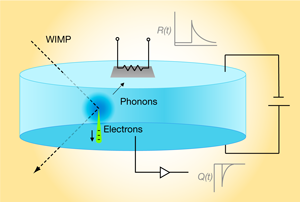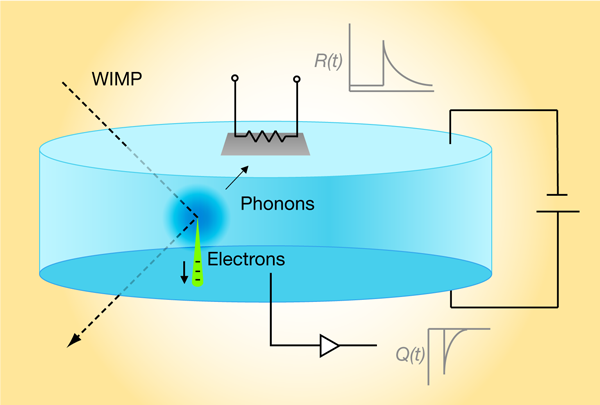Scaling up the search for dark matter
The dynamical evidence for dark matter in the universe—anomalously large velocities of stars within galaxies, and galaxies within clusters—goes back three-quarters of a century [1]. Within the past decade, precision measurements of cosmological parameters have pinned down the partitioning of the energy density of the universe rather neatly: dark energy accounts for roughly three-fourths, and matter of all forms makes up only a quarter. Of the latter, nonbaryonic dark matter accounts for about five parts in six [2]. What this elusive invisible matter actually is represents one of the pre-eminent questions in all of science. In Physical Review Letters, Ahmed et al. [3] report results from one of the collaborations involved in the hunt for dark matter that place new upper bounds on the extent of any possible interaction between certain kinds of dark-matter particles and normal matter.
One or more species of particle relics from the big bang are increasingly favored as the elusive dark-matter, with well-motivated beyond-Standard-Model candidates such as axions [4] and weakly interacting massive particles (WIMPs) [5] at the top of a short list—although one must be open to surprise. At present the neutralino, or WIMP, from the so-called supersymmetric theories enjoys wide currency as the favorite contender. These theories have the attractive feature of both preventing particle masses from being much heavier than they are, as well as unifying three of the four forces of nature. Such particles are expected to be in the range of 10 to 1000 times the proton mass, and should interact with cross sections characteristic of the weak interaction scale.
Intriguing hints for annihilation of supersymmetric dark matter in the universe have recently been seen in the form of anomalous positron yields measured by satellite- and balloon-borne cosmic-ray detectors, PAMELA and ATIC [6]; the recently launched Fermi Gamma-ray Space Telescope will soon weigh in with dramatically improved data. But even if supersymmetry were to be discovered at the LHC, a prospect recently rolled back another year by a catastrophic magnet failure, only the direct detection of WIMPs in our Milky Way halo would finally confirm their role as dark-matter particles.
With only a few such particles per liter wafting through the earth at a thousandth the speed of light, such a project does not at first blush look encouraging. Nevertheless, two decades ago, Bernard Sadoulet of Berkeley and Blas Cabrera of Stanford launched the Cryogenic Dark Matter Search (CDMS) to hunt for WIMPs by watching for very rare low-energy nuclear recoils, of order 10 keV, associated with their scattering from ordinary matter. Rates as dismal as one event per kilogram per year, or worse, would require constructing detectors that are both massive yet exquisitely sensitive. Furthermore, they must be shielded to a high degree from the myriad of standard radioactivity backgrounds, including cosmic rays, the latter necessitating their placement in deep mines.
Over the past twenty years, the CDMS collaboration has developed sophisticated technology to read out both the ionization and athermal phonons from recoil events within crystalline silicon or germanium detectors (see Fig. 1). Recording both signals powerfully discriminates electromagnetic background events (i.e., scattering of β or γ particles off electrons in the detector, which yields a higher ratio of ionization to phonon signals) from WIMP-induced nuclear recoils (which have a lower ratio). Background neutrons will produce nuclear recoils indistinguishable from those of WIMPs, but neutron backgrounds predominantly originate from cosmic-ray–muon interactions or naturally occurring fission in surrounding rock, and can be reduced acceptably by both passive and active shielding.
Low-energy β or γ events, on the other hand, originate from even the most minute contamination of the surfaces of solid-state detectors (from their contact bonds, etc.) and can never be totally eliminated. Such backgrounds must be rejected by features of the detector’s own signals; problematically, surface β emissions suffer incomplete charge collection and thus can mimic nuclear recoil events at the lowest energies. Deployed as an array of towers of stacked silicon and germanium pucks, each of only a few hundred grams, a major CDMS background challenge will always be its large surface-to-volume ratio.
For many years, earlier results from the CDMS II detector array, located in the Soudan mine in Minnesota, had set the most stringent limits on the spin-independent cross section of supersymmetric dark-matter particles scattering with the nucleon. In a stunning development last year, however, the XENON10 collaboration, a collaboration of eleven institutions led by Elena Aprile of Columbia University, published limits from a five-kilogram active volume of liquid xenon located in the Gran Sasso Laboratory [7], besting the old CDMS limits by nearly an order of magnitude. The strategy of XENON10, and subsequent designs aimed at the 100–300 kg scale (LUX, XENON300), also capitalize on discrimination afforded by two signals per event, in their case, ionization and prompt scintillation from atomic excitations associated with the recoil, as well as excellent three-dimensional position sensitivity. Furthermore, proponents argue that it should be possible to purify liquid xenon adequately to enable construction and operation of very large monolithic detectors very soon. That having been said, the published XENON10 exclusion curve, reaching a cross section of 4.5×10-44cm2 for 30 GeV mass WIMPs, was based on data for which the event region of interest was not background-free, and required careful modeling and subtraction.
Ahmed et al. now issue a strong rejoinder in the debate. From their first five-tower analysis of their upgraded array, CDMS II has come back into parity with XENON10, publishing a spin-independent WIMP-nucleon cross section of 4.6×10-44cm2 at 60 GeV mass. Most significantly however, the CDMS limit was derived from the expected WIMP event region (in the plane of ionization yield vs energy), which was completely background-free. This achievement required a highly refined understanding of the response of each detector, incorporating dependencies on the event timing, energy, and position into the analysis.
The two experiments taken together—XENON10 superior at lower masses and CDMS II at higher—are now encroaching well into the region where discovery may be lurking, a marvelous feat considering that a scattering cross section of order 10-44cm2 corresponds to a mean free path measured in light years of solid lead. Expectations should be tempered, however, as supersymmetry as a theory has an enormous dimensionality and is largely unconstrained. Parameter explorations of supersymmetry performed with a view to understanding the implications for experiments generate landscapes extending orders of magnitude in both mass and cross section, some regions of which always lay beyond the pale of any conceivable experiment [8]. It is an aphorism in the field that all dark-matter searches are much more useful for discovery than exclusion!
But the real and pressing near-term goal for both the cryogenic noble liquid and solid-state camps is a convincing demonstration that their technology is both scalable and affordable. The Department of Energy and the National Science Foundation will commit large investments in the 2010 time frame—in the ten to hundred million dollar range—on one or more metric-ton-scale detectors capable of discovering or excluding supersymmetric dark matter down to 10-46cm2, in the Deep Underground Science and Engineering Laboratory (DUSEL) in South Dakota, or other sites around the world. The Europeans are on a similar timetable, and the Japanese have already launched X-MASS, a project to construct an 800 kg single-phase xenon detector [9].
For future liquid xenon detectors, larger detectors will be self-shielding from backgrounds, with the outer regions of the bath acting as an active veto for the inner fiducial region on which the real analysis will be performed. On the other hand, larger volumes also imply longer transport paths for both the prompt ultraviolet scintillation photons and drifting electrons. While attenuation measurements done in simple test setups seem favorable, for a detector system the proof of the pie is always in the tasting.
For CDMS, a key demonstration will be high reliability in production and operation. It is telling that of the 19 germanium detectors deployed, only 7 produced data that could be readily analyzed for this report; the rest exhibited degraded performance either right away or after thermal cycling. Also ahead is development of a robust at-scale costing of this technology. SuperCDMS, the next step on their roadmap, will roll out larger individual detectors, and is also expected to significantly advance understanding of the industrialization issues.
The signature of WIMPs will be subtle, and definitive proof and further investigation of halo dark matter will require observation by at least two detectors, ideally of different modalities. Success of both technologies will be critical to the US program in direct detection of supersymmetric dark matter.
References
- F. Zwicky, Helv. Phys. Acta 6, 110 (1933); V.C. Rubin and W.K. Ford, Astrophys. J. 159, 379 (1970)
- Max Tegmark et al., Phys. Rev. D 69, 103501 (2004); E. Komatsu et al., arXiv:0803.0547v2
- Z. Ahmed et al. (CDMS Collaboration), Phys. Rev. Lett. 102, 011301 (2009)
- R. Bradley et al., Rev. Mod. Phys. 75, 777 (2003)
- Richard J. Gaitskell, Annu. Rev. Nucl. Part. Sci. 54, 315 (2004)
- O. Adriani et al. (the PAMELA collaboration), arXiv:0810.4995v1; J. Chang et al. (the ATIC collaboration), Nature 456, 362 (2008)
- J. Angle et al. (the XENON10 collaboration), Phys. Rev. Lett. 100, 021303 (2008)
- G. Jungman, M. Kamionkowski, and K. Griest, Phys. Rep. 267, 195 (1996); G. Bertone, D. Hooper, and J. Silk, 405, 279 (2005)
- For comprehensive status reports of all current dark matter searches, see talks and proceedings within “idm2008 – Identification of Dark Matter 2008,” 18-22 August 2008 (Stockholm) http://agenda.albanova.se/conferenceDisplay.py?confId=355.





